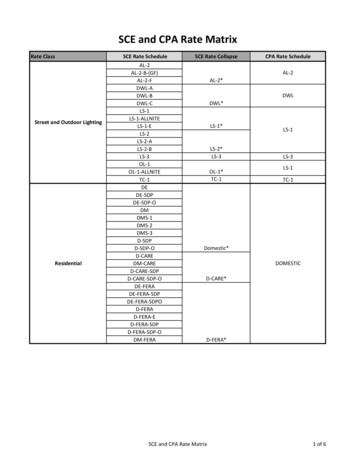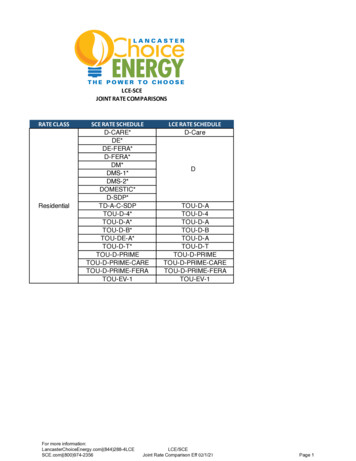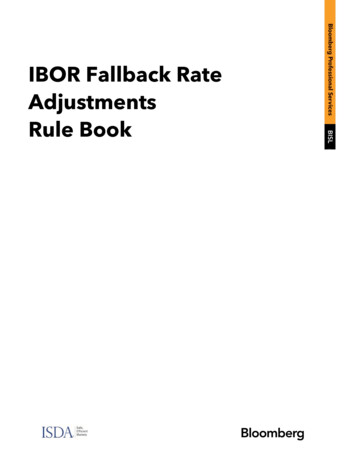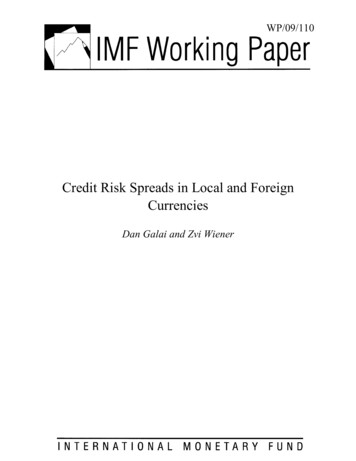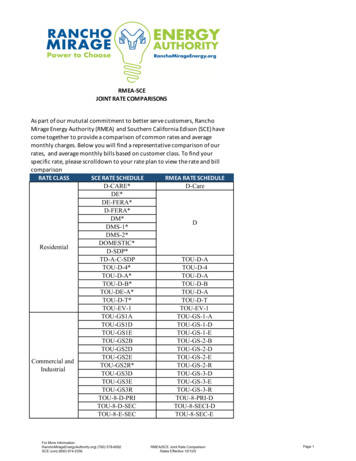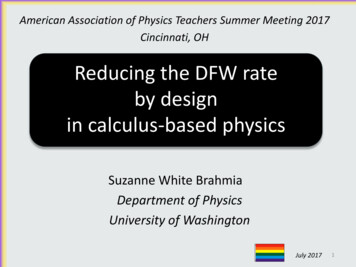
Transcription
American Association of Physics Teachers Summer Meeting 2017Cincinnati, OHReducing the DFW rateby designin calculus-based physicsSuzanne White BrahmiaDepartment of PhysicsUniversity of WashingtonJuly 20171
Focus of this talkLarge-enrollment calculus-based introductoryphysics courses at Rutgers University2
Overview Characterize populations of successful andunsuccessful students in a typical largeenrollment calculus-based intro physics course(Rutgers) Considerations of the distinguishing features ofeach group Description of course designed to reduce DFWrate Evidence that demographic differences arereduced3
What do we mean by“success” and “failure” Operational definition:– success top quartile of course grades– failure bottom quartile of course grades How do we put them into these quartiles?– assessment (mostly)– participation (somewhat) What are we assessing?– absolute content knowledge– gain in content knowledge?– Other things?4
Focus on absolute knowledge Favors students who already have a lot to beginwith Send a message to those who don’t (or perceivethey don’t) that they are out of their league By focusing uniquely on competitive absolutemeasures, we tell our students that thoseprepared with lots of content knowledge belong,those who aren’t belong in the back seat.5
Who has a lot to begin with?What are common background characteristicstop quartile and bottom quartile in a typicalcalculus-based introductory physics?6
Mean SAT and Mean MHI(Median Household Income of HS attended)(2013, N 461)Analytical Physics (AP)mean SATmean MHI00.2highest 25%0.40.6middle 50%lowest 25%0.817
Mean SAT and Mean MHI(Median Household Income of HS attended)(2013, N 461)Analytical Physics (AP)mean SATmean MHI00.2highest 25%0.40.6middle 50%lowest 25%0.818
Mean SAT and Mean MHI(Median Household Income of HS attended)(2013, N 461)Analytical Physics (AP)mean SATmean MHI00.2highest 25%0.40.6middle 50%lowest 25%0.819
The DFW rate problem is in part a SES problem10
NJ school math and socioeconomics(J. Anyon 1980)MHIQuintileSocioeconomicStatusSchoolwork culture2ndWorking classWork is evaluated for obedience to procedure.Students learn to imitate the teacher in math class.3rd-4thMiddle classWork is getting the right answer. Creative activities areoccasional, for fun but not part of learning. Studentsare given some choice in math on which of twoprocedures to use to get an answer.4th-5thAffluentprofessionalWork is a creative activity carried out independently.The products of work should show individuality.Students gather data and use it to learn aboutmathematical processes.Top 1%Executive eliteWork is developing one’s intellectual powers; studentsinvent ways to measure and calculate in math class.11
NJ school math and socioeconomics(J. Anyon 1980)MHIQuintileSocioeconomicStatusSchoolwork culture2ndWorking classWork is evaluated for obedience to procedure.Students learn to imitate the teacher in math class.3rd-4thMiddle classWork is getting the right answer. Creative activities areoccasional, for fun but not part of learning. Studentsare given some choice in math on which of twoprocedures to use to get an answer.4th-5thAffluentprofessionalWork is a creative activity carried out independently.The products of work should show individuality.Students gather data and use it to learn aboutmathematical processes.Top 1%Executive eliteWork is developing one’s intellectual powers; studentsinvent ways to measure and calculate in math class.12
“The biggest obstacle to success is NOTlimitation with math skills or knowing thedefinition of density It’s the institutionalsuppression of thinking.”-Richard Steinberg 201113
Slide courtesy of Michael Marder14
Slide courtesy of Michael Marder15
In NJ, the DFW problem is in part a POC problem16
Problems1. Many students struggle to assimilate themathematical habits of mind that characterizesuccess in physics.are disproportionately few African American,Latino and Native American physics majors andgraduate students in physics.To mathematize in physics means to go back andforth between the physical and the symbolicworlds.17
Problems1. Many students struggle to assimilate themathematical habits of mind that characterizessuccess in physics.1. There are disproportionately few AfricanAmerican, Latino and Native American studentsearning grades in the top quartile of a typicalintroductory calculus-based physics course.iphysics means to go back and forth between thephysical and the symbolic worlds.18
ProblemMost physics students, and especially studentsfrom low SES high schools, struggle to assimilatethe habits of mind we model, and they leave ourcourses with even less expert-like mathematicalattitudes and habits.mathematize in physicsmeans to go back and forth between thephysical and the symbolic worlds.19
Analytical Physics (AP)%URM%female00.5highest 25%1middle 50%1.52lowest 25%20
Analytical Physics (AP)%URM%female00.5highest 25%1middle 50%1.52lowest 25%21
Analytical Physics (AP)%URM%female00.5highest 25%1middle 50%1.52lowest 25%22
Viewpoints(Hazari & Potvin 2005) Perhaps there is a biological foundation. Perhaps, as a subject, physics just naturallyappeals to its current practitioners only. Perhaps there is an (unintended) bias in theculture of the physics community that favorsthe current majority by repelling the minority.23
Viewpoints(Hazari & Potvin 2005) Perhaps there is a biological foundation. Perhaps, as a subject, physics just naturallyappeals to its current practitioners only. Perhaps there is an (unintended) bias in theculture of the physics community that favorsthe current majority by repelling the minority.24
Underpinnings of the Intervention25
What attracts curious, hard workingstudents to physics, and what repelsthem from it?26
Transmission mechanisms of cultural norms(adapted from Hazari & Potvin 2005) Pedagogically: through instructional practices,conveying what it means to do physics Socially: encouraging/discouraging through thestructure, interactions, and treatment in the physicscommunity27
Transmission mechanisms of cultural norms(adapted from Hazari & Potvin 2005) Pedagogically: through instructional practices,conveying what it means to do physics Socially: encouraging/discouraging through thestructure, interactions, and treatment in the physicscommunity28
Target characteristics of physicists(interrelated) Physics Identity: Physics identity and beliefs about belonging areimportant characteristics of all successful students. Reward andpraise are important to its development. (Potvin & Hazari 2013,Hazari et. al. 2010, Stout et. al. 2012)how a person is viewed by self and others,and how they want to be viewed Self-efficacy: Self efficacy is a significant predictor of success for allstudents. (Sawtelle 2011)the extent or strength of one's beliefin one's own ability to succeedat physics-related tasks29
What obstacles might you encounteras an African American female?(Horna & Richards AAPT 2017) Middle school (lower SES quintile); African American girls inphysics course - High self efficacy Free response, physics identity:– “As an African American female people wouldn’t take meseriously.”– “I will be look down upon. I will be underestimated, especiallysince I’m a girl and African-American.”– “I would face criticism, and the feeling of because of my colorthings I do and say would be ‘wrong’ ”– “Knowing that there aren’t others like me would make me feelnot only strong, but confused on why there aren’t many like me.”30
Strong Physics Identity After taking introductory physics, female studentsare less likely to think they would make a goodphysicist (controlling for grades and background)(Kost et al. 2009) Less-likely for women, African American & Latinxstudents (Hazari et al. 2013)31
Developing a healthy community ofpractice32
Theoretical framework: community of practice(Wegner et. al. 1998, 2002) is a group of people who are activepractitioners. made up of domain, community, and practices provides a way for practitioners to share tipsand best practices, ask questions of theircolleagues, and provide support for eachother.33
DENTITYGroup WorkStudentcenteredPedagogical PracticesINTRODUCTORY PHYSICSCOMMUNITY OF PRACTICE34
micro aggressions andmicro validations aggressions: brief, everyday exchanges thatsend (unintended) denigrating messages tocertain individuals because of their groupmembership validations: just the opposite no one event will make or break, but theaccumulation can make a difference one wayor another.35
some microagressions in a professionalsetting interrupting and dominance of activity by members of themajority group assuming physics prowess is measured only by rapidtextbook problem solving downplay student complaints of bias very low exam averages language use (fa*, nig*,bitc*, etc.) jokes that call out gender, ethnicity, sexual orientation etc. assumptions of heternormativity ignoring any of the above as the leader of a collaborativelearning environment36
Brochure image U of Northern Georgia37
unityExperimentalPracticesUnbalanced,uneven access standingSELF-EFFICACYVisibilityPHYSICSIDENTITYLack of facultyfrom underrepresentedgroupsGroup redTraditionaltextbook problemsolvingPedagogical PracticesMICRO AGGRESSIONS38
unitybased on researchvalidated curriculaand tyPHYSICSIDENTITYfaculty fromunderrepresentedgroupsGroup tcenteredbased on researchvalidated curriculaand methodsPedagogical PracticesMICRO VALIDATIONS39
First steps(Hazari & Potvin 2005) rethinking physics curriculum and culture toinclude broad and diverse worldviews change the social climate towardscollaboration instead of competition make physics more accessible to everyone40
The Rutgers Intervention 1968 – “War on Poverty” created EOF(Equal Opportunity Fund) Late 80s – Horton and Holton createdinfrastructure Late 80s/early 90s - State providedpermanent, competitive higher educationfunding opportunity that institutionalizedgrant funded innovation41
EOF: Essential co-existent program entirely need-based sponsors more thanone-third of the AfricanAmerican and Latinxstudents in NJ highereducation.42
The Intervention – model Pre-physics model: 1 semester of remedialmathematics, not effective because:– Required extra year to obtain degree– Stigma– One semester too short to prepare for Analytical Physics replaced after just two years; adopted Parallelmodel43
1st YearMechanics, Waves, andThermodynamics2nd YearElectromagnetism, Optics,Modern PhysicsExtended AnalyticalPhysics (EAP I)3 credits per semesterExtended AnalyticalPhysics II (AP II)Analytical Physics (AP I)3 credits per semester2 credits per semester
Overview Placement based on low math placement test scores(pre-calculus) Some space available for students from regular courseand sophomores 60% students are in EOF program Higher percentage of female, Latinx/African Americanstudents than AP I
The Culture: Assumptions binary gender studies only scratch the surfaceof gender and sexual orientationbelongingness issues these interventions will benefit all groups– giving voice– building agency– broadening meaning of being a physics person– diversifying meanings of success46
Rethinking physics culture andcurriculum increasing *collective intelligence explicit part ofcourse goals generous praise:– creative ideas (including naïve one),– effective collaboration– showing professional levels of responsibility using research-validated methods/materials tohelp students develop their own physics habits ofmind*Woolley 201047
Change social climate towardscollaboration instead of competition explicit no bias-tolerance policy– in syllabus– part of classroom norms intentionally use gender-neutral pronouns no assumption of heteronormativity inpersonal/family lives discussing microaggressions/validations as part ofall staff (TAs, LAs) ongoing professionaldevelopment48
Making physics more accessible– advising students one-on-one fromunderrepresented groups to pursue opportunitiesin physics/engineering (e.g. REU, internships, gradschool)– taking action on any complaints of perceived bias– encouraging students who do poorly to come andtalk about how they can do better, and then letthem do most of the talking49
The curriculum50
Curricular Structure ISLE philosophy infused with Invention Tasks Scaffolded productive failure that places value on naïveideas Assessment:– Diverse (group presentations, oral quizzes, onlineproblems,etc.)– Nontraditional exam formats (open-ended problems,multiple choice, design questions, essay questions, etc.)– straight grading scale with opportunities for points recovery– 50% of grades based on collaborative activities– Scientific Ability Rubrics used for formative assessment51
Challenges The majority needs to recognize the ubiquitousadvantage that majority privilege carries, and bewilling to part with that advantage. This requiresre-examining what it means to know physics andhow we measure success. Microaggressions are unintentional, so requireconscious thought to avoid. Representation gaps target their start precollege.How can physics directly influence math andscience teaching in low SES schools?52
Some results53
Physics Passing Rate (year 1)% of incoming 92&93) Steady State('07&'08)
100EAP 1 vs AP 1 Final Exam'95 & '96Score8060AllWomenURM40200EAP 1AP 1
% of 1st-yr studentsRetention in STEMMajors10080AllWomenURM604020056
EOF- Supporting Each OtherStrong links with EOF Directors in Engineering isessential to success of our program.In addition to scholarships, EOF provides communitysummer programtutorial assistancereduced course loadextensive counseling servicesknowledge/caring regarding life circumstances ofstudents
Assessing Impact: how and who we study “Focusing on achievement gaps to the exclusion of otherconsiderations reinforces deficit models, implicitlypositions tests (and the culture that produced them) asunbiased, and often reduces student identities toessentialized categories (e.g., “all women.”).”Traxler, A. L., Cid, X. C., Blue, J., & Barthelemy, R. (2015) What works: “PER in the US oversamples from whiteand wealthy populations”Kanim, S.E. & Cid, X.C. (in preparation)58
FCI scores(2013)normalized gain for EAP I is 0.50 and for AP I is 0.1859
CLASS – Physics (2013)(Colorado Learning Attitudes about Science Survey)physics overall change post-pre60
Extended Analytical Physics (EAP)mean SATmean MHI00.10.2highest 25%0.30.40.5middle 50%0.60.70.80.91lowest 25%61
Extended Analytical Physics (EAP)mean SATmean MHI00.10.2highest 25%0.30.40.5middle 50%0.60.70.80.91lowest 25%62
Extended Analytical Physics (EAP)mean SATmean MHI00.10.2highest 25%0.30.40.5middle 50%0.60.70.80.91lowest 25%63
64
Assistant Dean, Michael BrownRutgers School of EngineeringDoctoral Candidate,Engineering Education Research65
How can physics directly influencemath and science teaching in low SESschools?66
The future – Dr. Geraldine Cochran67
Thank you!68
mean SAT Analytical Physics (AP) highest 25% middle 50% lowest 25%. 9 Mean SAT and Mean MHI (Median Household Income of HS attended) (2013, N 461) 0 0.2 0.4 0.6 0.8 1 mean MHI mean SAT Analytical Physics (AP) highest 25% middle 50% lowest 25%. The DFW rate problem is in part a SES problem 10. NJ school math and socioeconomics



